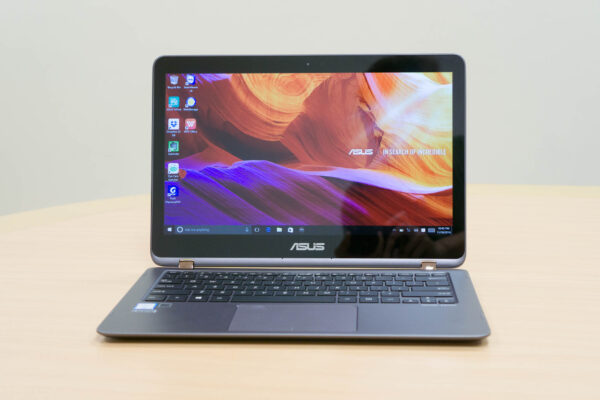If you’re looking for 2-in-1 tablet cum notebook devices, ASUS offers many choices. Sometimes, too many, and the similar names don’t help. Here’s the ZenBook Flip UX360UA, which is in many ways similar to the UX360CA I reviewed recently, but has an upgraded Intel Core i7 processor. ASUS has also made some small, but notable, design tweaks.
The ZenBook Flip UX360UA is a 2-in-1 device, with a 13.3-inch touchscreen display that flips around 360° that lets it convert between notebook and tablet mode. It’s ultra-thin, and yet comes with plenty of features to make this a very versatile device with pretty good performance.
Since the UX360UA is a minor tweak of the previous UX360CA, many of my comments of the two devices are similar. Like all ZenBooks, the UX360UA sports the same design language that has become quite familiar. It has an all aluminium unibody construction, with a concentric circle pattern on the cover, that feels very solid.
The current design has worked pretty well, and perhaps ASUS feels there’s no need to change what works, but I do find it has become a little old and could do with some refresh. For example, the two halves of the basic clamshell design, the notebook part and the display part, are just two halves that don’t quite blend together as one body. This is particularly bad on the UX360UA as you can see in the photo below.
The top display part and the bottom keyboard part, when flipped over, don’t come together very well.
The ZenBook Flip UX360UA measures 323 x 220 x 13.9mm, so it’s pretty thin. It’s also very light, coming in at 1.3kg including battery. The 45W power brick’s quite light and compact too if you need to bring it around.
The display hinge holds the screen in practically any position, and easily folds around the back so you can hold the ZenBook Flip like a tablet. You can easily position it in tent-mode too, if that’s how you prefer to use it.
In tablet mode, the keyboard faces outward so your hands may press on the keys or trackpad. The ZenBook Flip, of course, knows and disables those input. It probably doesn’t feel so good, but it works.
The 13.3-inch screen is gorgeous. With 3200×1800 resolution in 16:9 aspect ratio, the display is bright and vibrant, with 72% NTSC colour gamut. It supports 10-fingers multi-touch, and while it isn’t built for pen-input, it can detect a touch area of just 5mm, which is more sensitive than the 9mm industry standard.
The ZenBook Flip is quite sensible with its port offerings. It has some, or just one, of those forward thinking USB-C ports, but it also includes a variety of other legacy ones.
On the left side, you’ll find one of the two USB 3.0 Type-A ports, physical volume rocker, and a power button.
On the right side, there’s a SD card slot, a headphone jack, a USB-C (USB Type-C) port, a HDMI port, the other USB 3.0 Type-A port, and the DC power input port.
I think this is a very practical offering of ports. Not only is there the USB-C port, but there are the more widely-used USB Type-A ports. I would offer the suggestion that ASUS should have gone with a second USB-C port in place of the DC power input port. That would be the most practical arrangement.
The keys on the ZenBook Flip’s keyboard are plastic, but in the champagne gold colour of the notebook I received, the keys are in the same colour, and the entire keyboard blends in seamlessly to the aluminium body around it. It looks really good.
The keyboard has a spacious layout. The large backlit keys travel 1.5mm deep, and the keyboard is very comfortable to type on.
The touchpad is spacious, larger than that of the average notebook, and supports four-finger touch. The smooth surface finish and accurate tracking make the touchpad a joy to use. The touchpad is clickable at the bottom, though nowadays clicking isn’t needed much anymore with tapping and other gestures support, all of which work perfectly well here.
Speakers on the ZenBook Flip are fitted on the underside of the notebook, so they are downward firing. It’s not ideal, but they work fine generally. Except that when in tablet mode, the speakers are sandwiched inside and fire against the underside of the display. With ASUS SonicMater technology and Harmon Kardon tuning, the ZenBook Flip delivers superior audio and overcomes the challenging size constraints of ultra-thin notebooks.
The ZenBook Flip UX360UA in this review is powered by Intel’s Core i7-6500U processor, paired with Intel HD Graphics 520. It is fitted with 8GB of RAM and a large 512GB M.2 SSD. Performance is excellent for every day use. Quite notably, however, the fan runs quite aggressively to keep the i7 processor cool, and the noise it generates could be a distraction for some people.
Other specs on the ZenBook Flip include 2×2 Intel AC 8260 Dual Band 802.11ac Wi-Fi, Bluetooth 4.1, a 720p webcam, and a 54 Whr battery.
This version of the ZenBook Flip UX360UA is new. I’m waiting for ASUS to get back with details on price and availability.
Conclusion
The ZenBook Flip UX360UA, with the 3200×1800 resolution display and Intel Core i7, is a 2-in-1 notebook cum tablet device that offers great performance, versatility, and good design.
Pros:
- Ultra-light, ultra-thin
- Versatile design
- Great performance for general use
- Offers USB-C and legacy ports
Cons:
- Fan gets a little noisy

